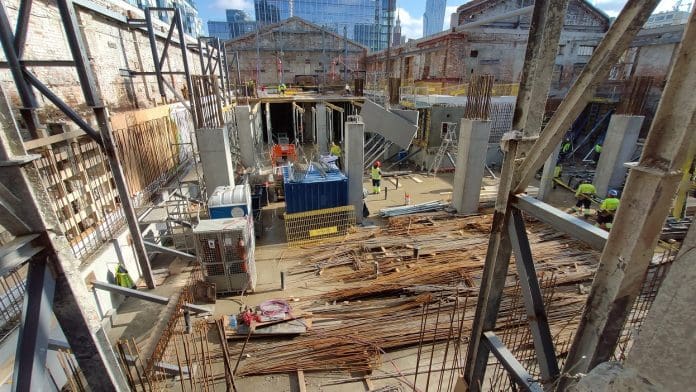Aleksander Śpiewak, director at RSK Polska, explores the opportunities to keep the history and heritage of industrial buildings alive at the same time as offering a new lease of life
Many of our major cities were home to once-thriving industry.
In more modern times, the buildings that housed these industries are often unused and have been left to fall into disrepair. But with remedial action, it is possible to bring new life to these landscapes while preserving the heritage of industrial buildings.
Warsaw is the same as many cities across Europe: for centuries, it was sustained by industry, with factories and warehouses scattered on its edges.
They were at the centre of communities then but have since fallen into decline as time left these industries behind.
Now, as the urban sprawl has brought the factory sites into the city centre, we have a unique opportunity to revitalise these spaces for modern uses at the same time as marking our heritage.
Following the end of the Cold War in the early 1990s, Poland underwent a period of significant economic change.
This growth, however, left many of our nation’s traditional industries behind as different economic opportunities arose. Now there is renewed drive to bring these sites back to life, as they are home to so much of our history.
However, preservation through development is never the easiest option: for most regeneration projects, it is cheaper and easier to demolish the site completely and rebuild using recovered, original materials.
In Warsaw, many of the city’s historic post-industrial buildings are protected by law, meaning preservation is the primary, and often only, route.
Managing the legacy of heavy industry
Since the turn of the 19th century, Poland was a big producer of metal products to support its growing shipbuilding and manufacturing industries.
Bronze and steel were processed into products ranging from military armour to ornaments, a booming industry that employed generations of Poles. Many of these factory sites still stand, as they do across much of Europe – the cloth mills of Leeds in England, for example – but have not been used for industrial purposes for many decades.
When we approach the regeneration of these sites into something that can be used and enjoyed today, this industrial heritage can present challenges, especially so when taking a preservation approach.
Where heavy industry has been located, hazardous materials have the potential to seep into the ground and the walls of the building. Before any redevelopment can take place, an understanding of these legacies must be gained.
The recent regeneration of Norblin Factory, for example, required detailed remedial work to transform the former bronze processing factory into a modern mixed-use entertainment and office space.

Following analysis of the ground, heavy metals and total petroleum hydrocarbons were found on-site, and the RSK Polska team developed a revised action plan to manage the associated risk.
Though not present in the building fabric – as can be the case in former industrial settings, which presents an entirely more complex challenge – contaminants in the ground required effective remedial action to enable the project to be realised.
Without such action, the potential harm of soil contamination is significant and can have wide-ranging consequences. Contact with contaminated soil can lead to various health problems, including skin rashes, respiratory issues and even long-term chronic illnesses or cancer.
Contaminants in soil can also leach into groundwater or be carried by rainwater run-off into nearby bodies of water, leading to water contamination. This can then have adverse effects on aquatic life and disrupt local water supplies.
To safely remove heavy metals and total petroleum hydrocarbons, which included benzene, toluene, ethylbenzene and xylene (BTEX) and polycyclic aromatic hydrocarbons, the team needed to excavate to a depth of 17m below ground level.
The presence of heavy metals and hydrocarbons in the soil at the Norblin Factory site was related to long-term industrial activity associated with metal processing and the use of heavy oils in the production process.
Assessments of the specific contaminants present opened up options in how the removed soil could be processed – 2,000 tonnes (hazardous materials) needed to be disposed of via landfill because of high concentrations of contaminants, but 328,000 tonnes (non-hazardous materials) could be recycled and reused, mainly in industrial and transportation areas.
In total, 330,000 tonnes of contaminated soil was removed from the Norblin Factory site, ensuring no future risk was posed in its new use.
Considering the appropriate ground remediation of any site is important and is especially so when it is being redeveloped. Improper remediation may pose a threat to the lives and health of people who will later be users of the property.
Opportunities to preserve the heritage of industrial buildings
At Norblin, and at other sites across Europe, a preservation approach is vital. While it may be cheaper and easier to start again, keeping these buildings as they were also keeps our history alive. Warsaw is not unique across the region; when the Second World War came to an end, much of the city, and the country for that matter, was gone.
In the following decades, it was rebuilt to what it is now. Through the post-war period, our cities were rebuilt by us and embody a history we must remember. Preservation ensures we keep our heritage alive at the same time as marking progress.
Like many sites across Poland, Norblin is now a vibrant centre for social activities and work, something that is there for us all.
It houses the BioBazar organic food market, the KinoGram Cinema and Warsaw’s largest multicultural food hall, Food Town. Most importantly, it maintains what it once was – a centre of employment and economic growth that has survived with us.
Taking the regeneration by preservation approach breathes new life back into our historic landscape, bringing it into our present.
Aleksander Śpiewak
Director
RSK Polska














